![]()
![]()
![]()
Use LEFT and RIGHT arrow keys to navigate between flashcards;
Use UP and DOWN arrow keys to flip the card;
H to show hint;
A reads text to speech;
77 Cards in this Set
- Front
- Back
|
What are the functions of the limbic system? |
- Cortical information and hypothalamic impulses are integrated
- Homeostasis (autonomic regulation), Olfaction, Memory, Emotion = HOME |
|
|
What does "limbus" mean?
|
Border or hem between the new (neocortex) and the old (brainstem) brain
|
|
|
Why was the limbic lobe referred to as the rhinencephalon? Correct?
|
- Anatomists thought interconnections between the olfactory system and the limbic lobe indicated that this area had olfactory function
- Limbic system is not the "smell brain" rather it is just one of several sensory inputs |
|
|
What was Papez's understanding of the limbic lobe?
|
- Emotion is the product of the limbic circuit
- Input enters from other structures to be elaborated as emotion - Ultimately influences the hypothalamus to release appropriate hormones |
|
|
What are the structures that form Papez's Limbic Circuit?
|

Cingulate --> Hippocampus --> Fornix --> Mamillary Bodies --> Anterior Thalamus --> Cingulate
|
|
|
How was Papez's circuit modified by McLean?
|
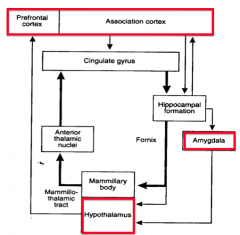
- Expanded to include hypothalamus, septal area, orbitofrontal cortex, nucleus accumbens (part of striatum), and amygdala
- Basic circuit is still there but with additional inputs and outputs |
|
|
What justifies the concept of the "limbic system"?
|
- Common physiologic and neurochemical properties
- Intricate anatomic connections - Common behavioral associations |
|
|
How was it established that the limbic system had common physiologic and neurochemical properties?
|
- Herpes virus has a special affinity for these regions (leads to severe memory and behavioral disturbance)
- Susceptible to kindling (process by which a seizure is initiated and its recurrence made more likely) and development of seizure foci - High density of cholinergic innervation and opiate receptors (involved in memory and perception of pain and pleasure) |
|
|
The limbic system is characterized by what kind of innervation and receptors? Functions?
|
- High density of cholinergic innervation and opiate receptors
- Mechanism for involvement of limbic system in memory and perception of pain and pleasure |
|
|
What provides the cholinergic input for the brain (memory)?
|
Septal nuclei and nucleus basilis of Meynert
|
|
|
What system is critical for positive reinforcing brain mechanisms?
|
Mesocorticolimbic Dopamine system
|
|
|
What does the fornix connect?
|
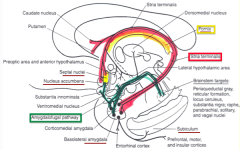
- Hippocampus
- Mammillary and Septal Nuclei |
|
|
What does the mammillothalamic tract connect?
|
- Mammillary bodies
- Anterior Thalamus |
|
|
What does the Perforant Path connect?
|
- Entorhinal cortex
- Dentate (Hippocampus) |
|
|
What are the efferent projections from the amygdala?
|
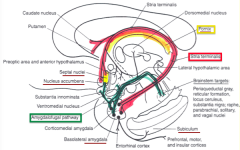
- Stria Terminalis (to septal nuclei and hypothalamus)
- Ventral Amygdalofugal Pathway (to hypothalamus and brainstem nuclei) - Directly to hippocampus, entorhinal cortex, and temporal and other neocortical areas |
|
|
What are the afferent projections to the amygdala?
|
- Stria Terminalis (from septal nuclei and hypothalamus)
- Ventral Amygdalofugal Pathway (from hypothalamus and brainstem nuclei - Lateral Olfactory Tract (from olfactory bulb and olfactory cortex) - Direct from Temporal Lobe (neocortical areas and hippocampus) |
|
|
What are the cortical structures of the "Outer Core"?
|
- Cingulate Gyrus
- Orbital Frontal Lobe - Subcallosal Area - Parts of Temporal Lobe (Hippocampus, Parahippocampal Gyrus, Uncus) |
|
|
What are the functions of the Cingulate Gyrus? Component of what?
|
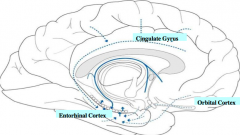
- Rostral - emotions and motor
- Caudal - visual spatial and memory - Outer Core |
|
|
What are the functions of the Orbital Frontal Lobe? Component of what?
|
- Personality
- Behavioral Control - Self awareness - Outer Core |
|
|
What are the functions of the Temporal Lobe (Hippocampus, Parahippocampus, and Entorhinal Cortex)? Component of what?
|
- Memory
- Outer Core |
|
|
What are the cortical structures of the "Inner Core"?
|
- Anterior Thalamic Nucleus
- Mammillary Body - Hypothalamic Nuclei - Septal Nuclei |
|
|
What are the functions of the Hypothalamic Nuclei? Component of what?
|
- Pleasure Center
- Autonomic regulation - involved in BP, feeding, temperature regulation, and immune response - Endocrine integration (ACTH and TSH secretion regulation from pituitary) - Also involved in maternal behavior * Inner Core |
|
|
Where do neurons in the hypothalamus project to? Functions?
|
Pituitary Gland
|
|
|
What are the functions of the Amygdala? Component of what?
|
- Preservation of self behaviors
- Emotion - Social behavior - Aggression and defense response - Sexual behavior - Affective significance of visual stimuli - Affect of faces - Affective regulation * Inner Core |
|
|
What are the functions of the Septal Nuclei? Component of what?
|
- Preservation of species behaviors
- Sexual behavior - Emotionality * Inner Core |
|
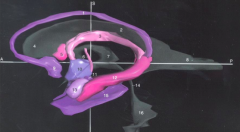
What is Structure 3 (light pink)?
|
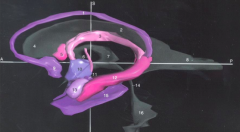
Fornix (3)
|
|
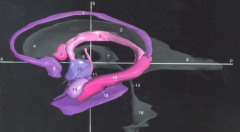
What is Structure 11 (small purple)?
|
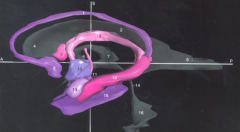
Mammillary Body (11)
|
|
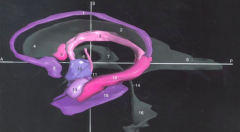
What is Structure 13 (light purple)?
|
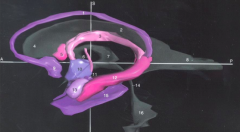
Amygdala (13)
|
|
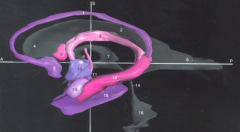
What is Structure 10 (blue/purple)?
|
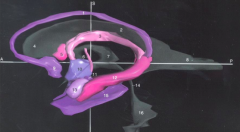
Hypothalamus (10)
|
|
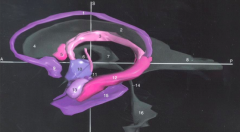
What is Structure 12 (hot pink)?
|

Hippocampus (12)
|
|
|
What does the Medial Forebrain bundle connect?
|
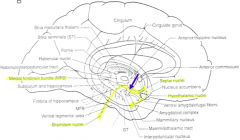
Hypothalamic nuclei with amygdala and brainstem nuclei
|
|
|
What causes the symptoms of Kluver-Bucy Syndrome in rhesus monkeys?
|

Bilateral large temporal lesions including amygdala, hippocampus, and uncus
|
|
|
What are the symptoms of Kluver-Bucy Syndrome in rhesus monkeys?
|
- Psychic blindness (lose ability to detect meaning of objects = visual agnosia)
- Oral tendencies (examine all objects by mouth) - Hypermetamorphosis (notice and react to every visual stimulus) - Tameness (no motor or vocal reactions w/ fear or anger) - Hypersexuality |
|
|
What are the symptoms of Kluver-Bucy Syndrome?
|
- Visual agnosia (loss of recognition of simple familiar objects or people)
- Increased oral activity - Hypermetamorphosis (attend and react to every visual stimulus within visual field - subsequent compulsive handling of object) - Placidity (flat affect, lack of aggressive behavior, absence of fear) - Hypersexuality (indiscriminate sexual advances) - Bulimia |
|
|
What can cause Human Kluver-Bucy Syndrome?
|
- Post traumatic encephalopathy
- Herpetic viral encephalitis (most common) - Anoxia - Subarachnoic hemorrhage - Pick's disease - Alzheimer's Disease - Bilateral temporal infarction - Focal status epilepticus * All have extensive lesions involving bilateral temporal cortex and amygdala * |
|
|
What causes the symptoms of Geschwind Syndrome?
|
- Sensory limbic hyperconnection - strengthening of synaptic connections
- Interictal (between seizures) personality in temporal lobe epilepsy |
|
|
What are the symptoms of Geschwind Syndrome?
|
- Increased concern w/ philosophical, cosmic, or religious issues
- Altered sexual behavior (usually hyposexual) - Hypergraphia (extensive writing - religious or philosophical in nature) - Viscosity (tendency towards interpersonal stickiness, difficulty breaking off conversation) - Interictal personality in temporal lobe epilepsy |
|
|
How are interictal personality (Geschwind syndrome) and Kluver-Bucy Syndrome related?
|
- Interictal personality - HYPER-connection
- Kluver-Bucy Syndrome - DIS-connection |
|
|
What are the most pleasurable regions of the brain as determined by electrode stimulation of the brain?
|
- Lateral Hypothalamus
- Medial Forebrain Bundle (connects hypothalamus and septum) - Nucleus Accumbens |
|
|
How was it determined that the lateral hypothalamus and the medial forebrain bundle were the "most pleasurable" regions of the brain?
|
Implanted an electrode into the hypothalamic and septal regions of a rat and found that rats would forfeit food and water, forget about sex, and even accept pain for an opportunity to self-stimulate
|
|
|
What NT systems are implicated in the pleasure from self-stimulation of the lateral hypothalamus and medial forebrain bundle?
|
- Catecholamines
- Dopaminergic systems (blocking dopamine caused transitory reductions in self-stimulation) |
|
|
How do addictive drugs affect the limbic system?
|
- Produce potent effects on behavior by enhancing mesolimbic dopamine activity
- E.g., heroin increases neuronal firing rate of dopamine cells - E.g., cocaine inhibits reuptake of dopamine |
|
|
Lesions to what area can produce pain, rage, or strong aversive reactions and long lasting hyperemotionality?
|
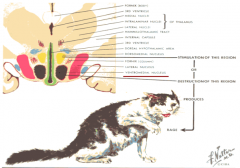
Lesions to ventromedial nucleus of hypothalamus
|
|
|
What happens if there are lesions to the ventromedial nucleus of hypothalamus?
|

Can produce pain, rage, or strong aversive reactions and long lasting hyperemotionality
|
|
|
What happens if there are lesions to the amygdala?
|
- Leads to tameness or reduced emotional excitability
- Monkeys become social isolates (important for normal social interactions); indiscriminate hypersexuality; devestating effect on maternal behavior |
|
|
What is the amygdala tied to?
|
Sensory association areas which participate in the modulation of emotional reactions
|
|
|
Discharges in the amygdala are most frequently associated with what?
|
Affective phenomena in patients with epilepsy
|
|
|
What brain structure plays a role in PTSD?
|
Amygdala - supports a classical fear conditioning; characterized by inability to extinguish fear memories
|
|
|
What affects the amount of activity in the amygdala during a social interaction?
|
- Emotional significance
- Degree of ambiguity |
|
|
Where are there cells that respond selectively to faces?
|
In the amygdala
|
|
|
The amygdala of humans plays a role in what?
|
Integration of emotions, fear and memory
|
|
|
What are the roles of the septal nuclei (septal region)?
|
- Positive control for sexual behavior (lesions to septal region abolish hypersexuality)
- Stimulation leads to 400% increase in sexual drive - Emotionality (lesions lead to rage and irritability) |
|
|
What are the implications of septal region lesions?
|
- Abolishes hypersexuality
- Enhancement of social contacts - Tumors result in rage-like attacks and increased irritability |
|
|
What are the implications of hippocampal lesions?
|
Amnesia (inability to form new memories, but still can remember past memories)
|
|
|
If someone loses their old memories but can still form new memories, what is the cause?
|
Psychogenic Amnesia (not hippocampus)
|
|
|
If someone loses their new memories but can still form old memories, what is the cause?
|
Lesions to hippocampus, dorsal medial nucleus of thalamus, mammillary nuclei alone or in combination (necessary for declarative memory - acquisition of new facts and events)
|
|
|
What are the two forms of long-term memory?
|
- Explicit (Declarative) - for facts and events
- Implicit (Non-declarative) - for priming, procedural skills, classical and operant conditioning, and habituation and sensitization |
|
|
What are the two forms of Explicit (Declarative) Memory?
|
- Episodic - personal events in one's life, actively remembered, embedded in time and place
- Semantic - facts known rather than actively remembered |
|
|
What does the hippocampal formation consist of?
|
- Hippocampus
- Dentate Gyrus - Subiculum |
|
|
What structure has extensive connections with the hippocampus and amygdala?
|
Neocortex
|
|
|
What is the major efferent to the hippocampal formation? Afferent?
|
- Efferent - fornix
- Afferent - perforant path |
|
|
The hippocampus is important for what kind of memory?
|
Formation of episodic memories (personal events in one's life, actively remembered, embedded in time and place)
|
|
|
How does temporal lobe epilepsy affect the hippocampus?
|
Can lead to hippocampal sclerosis and atrophy (lose episodic memory)
|
|
|
What are some other causes of memory disorders besides lesions to the hippocampus?
|
- Dementia
- Head trauma - Stroke (less common because usually strokes are on one side) - Wernicke Korsakoff's |
|
|
What causes the symptoms of Wernicke Korsakoff's Syndrome?
|
- Chronic alcoholism and nutritional deficiency (thiamine)
- Lesions to mammillary bodies and thalamus |
|
|
What are the symptoms of Wernicke Korsakoff's Syndrome?
|
- Acute: confusion, disorientation, oculomotor dysfunction, ataxia
- Chronic: anterograde and temporally-graded retrograde amnesia |
|
|
What are the divisions of the Cingulate Gyrus and their functions?
|
- Anterior Cingulate - emotion and motor functions
- Posterior Cingulate - visuospatial and memory functions |
|
|
What are the changes after lesions to the anterior cingulate?
|
- Emotional blunting, decreased motivation, disruption of mating behavior, impaired maternal infant interactions, impatience, lowered threshold for fear or startle
- Abolish conditioned emotional vocalizations - Decreased pain ** Apathy, disinhibition, placidity (not easily upset or excited), depression, anxiety, obsessive-compulsive behaviors, heightened sexuality, bulimia |
|
|
What procedure can successfully treat OCD?
|
Cingulotomy
|
|
|
What can cause akinetic mutism (no desire or need to talk)?
|
Bilateral anterior cingulate cortex lesions
|
|
|
What causes the symptoms of Gilles de la Tourette Syndrome? Therapy?
|
- Abnormalities in Anterior Cingulate
- Lesions of AC can relieve OCD behaviors - Disconnection of AC from thalamus can reduce other Tourette's symptoms |
|
|
What are the symptoms of Gilles de la Tourette Syndrome?
|
- Complex coordinated movement patterns
- Obsessive compulsive behaviors - Tics, impulsive behavior |
|
|
What are the functions of the anterior cingulate?
|
Integration of thought, motivation, and emotion w/ movement
|
|
|
Excessive amplification of signals from the Anterior Cingulate can cause what?
|
- Excessive emotional signals --> anxiety and obsessive compulsive behaviors
- Excessive motor behavior --> tics and impulsive behavior - Excessive filtering of emotions --> apathy, akinesis, mutism |
|
|
What are the symptoms of Orbital Frontal Lobe Syndrome?
|
- Disinhibited
- Tactless - Bawdy - Boastful - Grandiose - Restless - Impulsive - Inattentive - Perseverative - Tendency to dress carelessly and eat gluttonously |
|
|
What are the symptoms of Frontal/Convexity or Dorsolateral - Frontal Lobe Syndrome?
|
- Apathetic
- Slow - Demonstrating little initiative or spontaneity - Responding in an automaton like manner - Vacancy of expression |
|
|
What are the symptoms of Medial Frontal Lobe Syndrome?
|
- Akinetic mutism |

